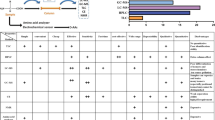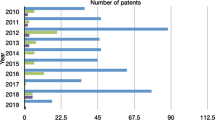Abstract
Vanillin (VAN) and ethyl vanillin (EVA) are widely used food additives as flavor enhancers, but may have a potential security risk. In this study, the properties of binding of VAN or EVA with calf thymus DNA (ctDNA) were characterized by multi-spectroscopic methods, multivariate curve resolution-alternating least-squares (MCR–ALS) algorithm and molecular simulation. The concentration profiles for the components (VAN or EVA, ctDNA and VAN–ctDNA or EVA–ctDNA complex) by the MCR–ALS analysis showed that VAN or EVA interacted with ctDNA and formed VAN–ctDNA or EVA–ctDNA complex. The groove binding of VAN or EVA to ctDNA was supported by the results from viscosity measurements, melting studies, denaturation experiments, and competitive binding investigations. Analysis of the Fourier transform infrared spectra corroborated the prediction by molecular docking that VAN and EVA preferentially bound to thymine bases region of ctDNA. The circular dichroism and DNA cleavage assays indicated that both VAN and EVA induced conformational change (from B − like DNA structure toward to A − like form), but didn’t lead to a significant damage on DNA. The fluorescence quenching of Hoechst 33,258–ctDNA complex by VAN or EVA was a static quenching, and hydrogen bonding and van der Waals forces were main forces. This study has provided insights into the mechanism of interaction between VAN or EVA with ctDNA, and may also help better understand their potential toxicity with regard to food safety.

VAN or EVA binds to A–T rich regions of ctDNA in the minor groove.











Similar content being viewed by others
References
Rehman SU, Sarwar T, Husain MA, Ishqi HM, Tabish M (2015) Studying non–covalent drug–DNA interactions. Arch Biochem Biophys 576:49–60
Basu A, Suresh Kumar G (2013) Minor groove binding of the food colorant carmoisine to DNA: spectroscopic and calorimetric characterization studies. J Agr Food Chem 62:317–326
Kashanian S, Khodaei MM, Kheirdoosh F (2013) In vitro DNA binding studies of aspartame, an artificial sweetener. J Photoch Photobio B 120:104–110
Maurya DK, Adhikari S, Nair CKK, Thomas PA (2007) DNA protective properties of vanillin against γ-radiation under different conditions: possible mechanisms. Devasagayam, Mutat. Res–Genet Tox En 634:69–80
Dolatabadi JEN, Kashanian S (2010) A review on DNA interaction with synthetic phenolic food additives. Food Res Int 43:1223–1230
Basu A, Suresh Kumar G (2016) Studies on the interaction of the food colorant tartrazine with double stranded deoxyribonucleic acid. J Biomol Struct Dyn 34:935–942
Wu D, Chen Z (2015) Study on the interaction between ginsenoside Rh2 and calf thymus DNA by spectroscopic techniques. Luminescence 30:1212–1218
Wang X, Xie X, Ren C, Yang Y, Xu X, Chen X (2011) Application of molecular modelling and spectroscopic approaches for investigating binding of vanillin to human serum albumin. Food Chem 127:705–710
Ni YN, Zhang GW, Kokot S (2005) Simultaneous spectrophotometric determination of maltol, ethyl maltol, vanillin and ethyl vanillin in foods by multivariate calibration and artificial neural networks. Food Chem 89:465–473
Shahabadi N, Hadidi S (2012) Spectroscopic studies on the interaction of calf thymus DNA with the drug levetiracetam. Spectrochim Acta Part A 96:278–283
Mukherjee T, Pessoa JC, Kumar A, Sarkar AR (2015) Formation of an unusual pyridoxal derivative: characterization of Cu (II), Ni (II) and Zn (II) complexes and evaluation of binding to DNA and to human serum albumin. Inorg Chim Acta 426:150–159
Naseri A, Hosseini S, Rasoulzadeh F, Rashidi MR, Zakery M, Khayamian T (2015) Interaction of norfloxacin with bovine serum albumin studied by different spectrometric methods; displacement studies, molecular modeling and chemometrics approaches. J Lumin 157:104–112
Liu R, Cheng Z, Li T, Jiang X (2015) Investigation of two blood proteins binding to Cantharidin and Norcantharidin by multispectroscopic and chemometrics methods. J Lumin 157:398–410
Gholivand MB, Jalalvand AR, Goicoechea HC, Gargallo R, Skov T (2015) Chemometrics: an important tool for monitoring interactions of vitamin B7 with bovine serum albumin with the aim of developing an efficient biosensing system for the analysis of protein. Talanta 132:354–365
Wang YJ, Zhang GW, Yan JK, Gong DM (2014) Inhibitory effect of morin on tyrosinase: insights from spectroscopic and molecular docking studies. Food Chem 163:226–233
Song WJ, Lin QY, Jiang WJ, Du FY, Qi QY, Wei Q (2015) Synthesis, interaction with DNA and antiproliferative activities of two novel Cu (II) complexes with norcantharidin and benzimidazole derivatives. Spectrochim Acta Part A 137:122–128
Sudhamani CN, Naik HB, Gowda KS, Giridhar M, Girija D, Kumar PP (2015) Synthesis, interaction with DNA and antiproliferative activities of two novel Cu (II) complexes with norcantharidin and benzimidazole derivatives. Spectrochim Acta Part A 138:780–788
Cui FL, Jin JH, Niu XQ, Liu QF, Zhang GS (2014) Spectroscopic and modelling analysis on the interaction of 3′-Azidodaunorubicin Semicarbazone with ctDNA. Aust J Chem 67:234–240
Tyagi G, Pradhan S, Srivastava T, Mehrotra R (2014) Nucleic acid binding properties of allicin: spectroscopic analysis and estimation of anti-tumor potential. BBA–Gen Subjects 1840:350–356
Heng MP, Sinniah SK, Teoh WY, Sim KS, Ng SW, Cheah YK, Tan KW (2015) Synthesis of a DNA-targeting nickel (II) complex with testosterone thiosemicarbazone which exhibits selective cytotoxicity towards human prostate cancer cells (LNCaP). Spectrochim Acta Part A 150:360–372
Bi S, Zhao T, Wang Y, Zhou H, Pang B, Gu T (2015) Binding studies of terbutaline sulfate to calf thymus DNA using multispectroscopic and molecular docking techniques. Spectrochim Acta Part A 150:921–927
Siddique HR, Mishra SK, Karnes RJ, Saleem M (2011) Lupeol, a novel androgen receptor inhibitor: implications in prostate cancer therapy. Clin Cancer Res 17:5379–5391
Zhang GW, Wang LH, Zhou XY, Li Y, Gong DM (2014) Binding characteristics of sodium saccharin with calf thymus DNA in vitro. J Agr Food Chem 62:991–1000
Mohamadi M, Hassankhani A, Ebrahimipour SY, Torkzadeh-Mahani M (2017) In vitro and in silico studies of the interaction of three tetrazoloquinazoline derivatives with DNA and BSA and their cytotoxicity activities against MCF-7, HT-29 and DPSC cell lines. Int J Biol Macromol 94:85–95
Shi JH, Chen J, Wang J, Zhu YY (2015) Binding interaction between sorafenib and calf thymus DNA: spectroscopic methodology, viscosity measurement and molecular docking. Spectrochim Acta Part A 136:443–450
Shahabadi N, Moghadam NH (2012) Determining the mode of interaction of calf thymus DNA with the drug sumatriptan using voltammetric and spectroscopic techniques. Spectrochim Acta Part A 99:18–22
Kashanian S, Javanmardi S, Chitsazan A, Omidfar K, Paknejad M (2012) DNA-binding studies of fluoxetine antidepressant. DNA Cell Biology 31:1349–1355
Ahmadi F, Alizadeh AA, Bakhshandeh-Saraskanrood F, Jafari B, Khodadadian M (2010) Experimental and computational approach to the rational monitoring of hydrogen-bonding interaction of 2-Imidazolidinethione with DNA and guanine. Food Chem Toxicol 48:29–36
Li XL, Hu YJ, Wang H, Yu BQ, Yue HL (2012) Molecular spectroscopy evidence of berberine binding to DNA: comparative binding and thermodynamic profile of intercalation. Biomacromolecules 13:873–880
Ross PD, Subramanian S (1981) Thermodynamics of protein association reactions: forces contributing to stability. Biochemistry 20:3096–3102
Shahabadi N, Hadidi S, Ghasemian Z, Taherpour AA (2015) Racemic R, S-venlafaxine hydrochloride–DNA interaction: experimental and computational evidence. Spectrochim Acta Part A 145:540–552
Rodrigues ARO, Carvalho MSD, Cardoso JAV, Calhelha RC, Queiroz MJR, Coutinho PJ, Castanheira EM (2014) Benzothienoquinolines: new one-pot synthesis and fluorescence studies of their interaction with DNA and polynucleotides. J Photochem Photobio A 294:20–30
Zhang GW, Ma YD, Wang LH, Zhang YP, Zhou J (2012) Multispectroscopic studies on the interaction of maltol, a food additive, with bovine serum albumin. Food Chem 133:264–270
Jalali F, Rasaee G (2015) Electrochemical, spectroscopic, and theoretical studies on the interaction between azathioprine and DNA. Int J B Macromol 81:427–434
Liu BM, Zhang J, Wang X, Zhang LP, Liu Y, Niu HY, Liu B (2015) Synthesis, DNA interaction and antimicrobial activities of three rimantadine analogues. J Lumin 159:128–133
Gao Y, Li J, Huang G, Yan L, Dong Z (2015) Spectroscopic studies on the interaction between anthragallol and DNA using of ethidium bromide as a fluorescence probe. Spectrochim Acta Part A 141:239–243
Chen W, Turro NJ, Tomalia DA (2000) Using ethidium bromide to probe the interactions between DNA and dendrimers. Langmuir 16:15–19
Xiao L, Wang H, Zhang Q, Zhu Y, Luo J, Liang Y, Zhang S, Zhou H, Tian Y, Wu J (2015) Novel ruthenium (II) polypyridyl complexes containing carbazole with flexible substituents: crystal structure, nonlinear optical properties and DNA-binding interaction. Dyes Pigments 113:165–173
Ramadevi P, Singh R, Jana SS, Devkar R, Chakraborty D (2015) Ruthenium complexes of ferrocene mannich bases: DNA/BSA interactions and cytotoxicity against A549 cell line. J Photochem Photobio A 305:1–10
Yue X, Chen Y, Yang G, Yue S, Su Z (2015) Synthesis, crystal structures and DNA-binding properties of Cd (II), Cu (II) and Ni (II) complexes with 2-(2-pyridyl) benzothiazole. Synthetic Met 200:1–6
Chakraborty A, Dash SP, Panda AK, Acharyya R, Biswas A, Mukhopadhyay S, Bhutia SK, Crochet A, Patil Y, Nethaji P, Dinda R (2015) Synthesis, X-ray structure and in vitro cytotoxicity studies of Cu (I/II) complexes of thiosemicarbazone: special emphasis on their interactions with DNA. Dalton T 44:6140–6157
Mohamadi M, Afzali D, Esmaeili Mahani S, Mostafavi A, Torkzadeh Mahani M (2015) Spectroscopic and electrochemical studies of the interaction between oleuropein, the major bio-phenol in olives, and salmon sperm DNA. Spectrochim Acta Part A 148:260–265
Ling X, Zhong W, Huang Q, Ni K (2008) Spectroscopic studies on the interaction of pazufloxacin with calf thymus DNA. J Photoch Photobio B 9:172–176
Li Y, Yang Z (2010) Rare earth complexes with 3-carbaldehyde chromone-(benzoyl) hydrazone: synthesis, characterization, DNA binding studies and antioxidant activity. J Fluoresc 20:329–342
Sahoo BK, Ghosh KS, Bera R, Dasgupta S (2008) Studies on the interaction of diacetylcurcumin with calf thymus-DNA. Chem Phys 351:163–169
Deiana M, Matczyszyn K, Massin J, Olesiak Banska J, Andraud C, Samoc M (2015) Interactions of Isophorone derivatives with DNA: spectroscopic studies. PLoS One 10:e0129817
Yuan X, Gu W, Xiao M, Xie W, Wei S, Zhou L, Zhou J, Shen J (2015) Interactions of CT DNA with hexagonal NaYF 4 co-doped with Yb 3+/tm 3+ upconversion particles. Spectrochim Acta Part A 137:995–1003
Tao M, Zhang GW, Xiong CH, Pan JH (2015) Characterization of the interaction between resmethrin and calf thymus DNA in vitro. New J Chem 39:3665–3674
Tyagi G, Charak S, Mehrotra R (2012) Binding of an indole alkaloid, vinblastine to double stranded DNA: a spectroscopic insight in to nature and strength of interaction. J Photochem Photobio B 108:48–52
Yang L, Fu Z, Niu X, Zhang G, Cui F, Zhou C (2015) Probing the interaction of anthraquinone with DNA by spectroscopy, molecular modeling and cancer cell imaging technique. Chem–Biol Interacts 233:65–70
Yousuf I, Arjmand F, Tabassum S, Toupet L, Khan RA, Siddiqui MA (2015) Mechanistic insights into a novel chromone-appended Cu (II) anticancer drug entity: in vitro binding profile with DNA/RNA substrates and cytotoxic activity against MCF-7 and HepG2 cancer cells. Dalton T 44:10330–10342
Acknowledgements
This work was financially supported by the National Natural Science Foundation of China (Nos. 31460422 and 21167013), the Natural Science Foundation of Jiangxi Province (20143ACB20006), the Foundation of Jiangxi Provincial Office of Education (GJJ150187), and the Objective-Oriented Project of State Key Laboratory of Food Science and Technology (SKLF–ZZA–201612).
Author information
Authors and Affiliations
Corresponding author
Rights and permissions
About this article
Cite this article
Xia, K., Zhang, G., Li, S. et al. Groove Binding of Vanillin and Ethyl Vanillin to Calf Thymus DNA. J Fluoresc 27, 1815–1828 (2017). https://doi.org/10.1007/s10895-017-2119-x
Received:
Accepted:
Published:
Issue Date:
DOI: https://doi.org/10.1007/s10895-017-2119-x




